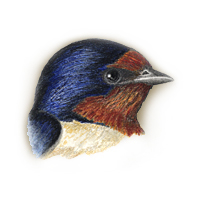|
Field
Guide IDs: BREEDING:
Open country,
savanna, esp near water, agricultural areas. 2
broods. DISPLAYS:
Males pursue
females in long, graceful courtship flights; on
landing, pair rub heads and necks, interlock bills
or mutually preen. NEST:
Usu plastered on
ledges and walls of building, occ in cave, culvert,
under bridge, or in cliff crevice; of mud pellets,
straw, heavily lined with feathers. Built in 7-14
days. EGGS:
White, spotted with
brown. 0.8" (19 mm). DIET:
Also occ berries,
seeds. CONSERVATION:
Winters from Lesser
Antilles, Puerto Rico, and Panama s to s tip of
S.A. Rare cowbird host. NOTES:
Often nest in small
colonies. Helpers often seen at nests, occ feed
nestlings; helpers usu yearlings or immatures from
first clutch aiding their parents. Breeders tend to
return to same colony, same cluster of nests within
colony, occ same nest and same mate. In spite of
not having brood patch, male incubates effectively
although not routinely. House Sparrows and phoebes
occ usurp nests. Drink and bathe on wing. After
fledging, young return to roost in nest for few
days. Common migrant and
summer resident throughout campus, attaching its
mud nests to walls and the eaves of
buildings. ESSAYS: Clutch
Sizes;
Parasitic
Swallows;
Cooperative
Breeding;
Coloniality;
Site
Tenacity;
Incubation. REFERENCES:
Beecher et al.,
1985; Brown, 1986; Brown and Brown, 1986; Withers,
1977. |
